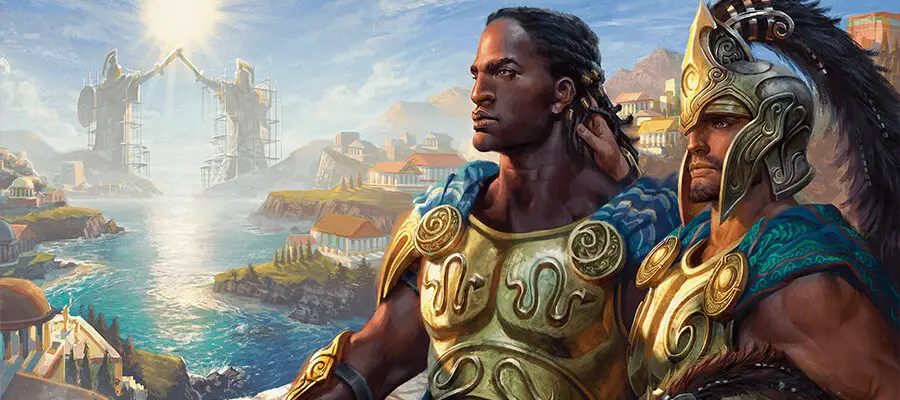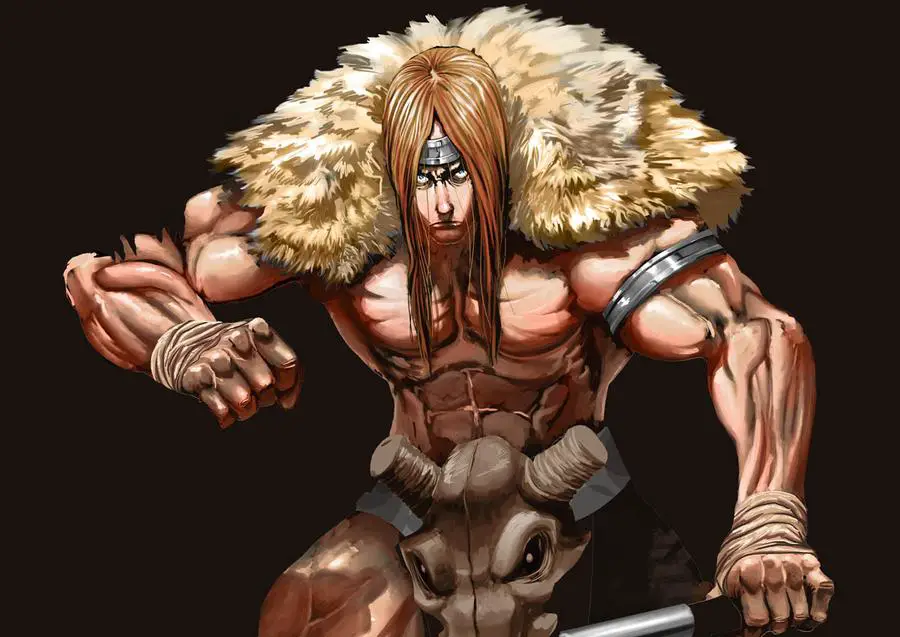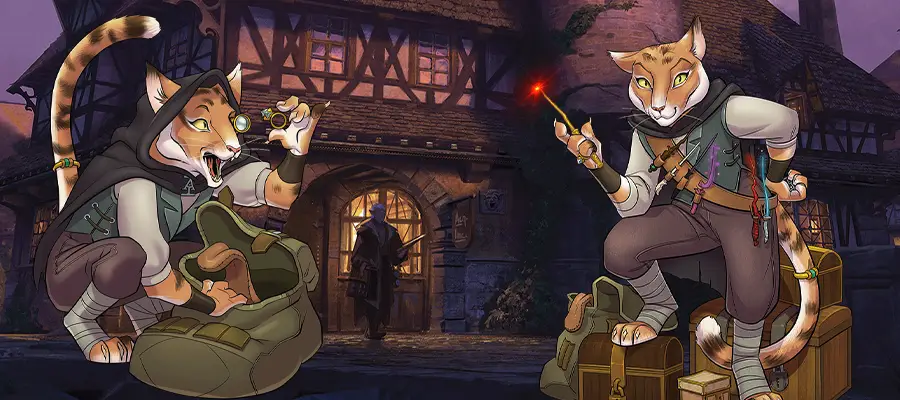This article’s featured image for D&D 5e Fighter Subclass Ratings is from Mythic Odysseys of Theros. This article contains affiliate links that add gold to our coffers.
Let’s find out which of D&D 5e’s Fighter subclasses are in charge and which are alone on Valentine’s Day! I enjoy analyzing subclasses to find their strengths and weaknesses. It helps me queue up the characters I eventually want to play when their times come.
Premise and Rating System
I’m rating each subclass based on the game overall for Fighters only, so I’m not comparing a Fighter subclass to a Wizard subclass. That wouldn’t feel fair. I also rate each subclass based on five criteria:
- Subclass Features: How the abilities and perks synergize. I look at all levels of play, not just low levels like many do these days. I play at high levels, plenty enough to look at those features.
- Game Design: How well do the features avoid misunderstandings, and how well do they fit into the game overall? Features that are clunky or feel exploitative will suffer.
- Fun: If a subclass feels effortless and enjoyable for the average player to pick up, it will be rated healthy here.
- Versatility: I like to see subclasses that can be played and flavored in multiple ways without feeling stuck.
- Lore & Roleplaying: Subclasses that evoke fantasy and live up to it will do well here.
This rating system is unscientific, but it’s the system that works for me! It also helps me to be objective and not feel burdened by community perceptions.
Quick Poll: Favorite Fighter Subclasses from the 5e Community
Before you read through my Fighter subclass ratings, let us know which is your favorite! Voting will reveal the votes of others, too.
Skip to Your Favorite Fighter Subclass Rating
— Arcane Archer
— Battle Master
— Cavalier
— Champion
— Echo Knight
— Eldritch Knight
— Psi Warrior
— Purple Dragon Knight Banneret
— Rune Knight
— Samurai
Arcane Archer Fighter Subclass Ratings (XGtE)
Summary of subclass features: Learn skills and choose Arcane Shot options to empower your ranged attacks with magical effects based on the schools of magic. Later, you gain trick shots and magical empowerment of your shots, and you gain more uses of Arcane Shot.
- Subclass Features: ★★★
- Game Design: ★★★
- Fun: ★★
- Versatility: ★★★
- Lore & Roleplaying: ★★★
Flutes’ Evaluation (3/5): The Arcane Archer limits itself to bows for its subclass features, so it will likely shy away from the Crossbow Expert feat. This can cause the player to have to choose between the class Crossbow Expert + Sharpshooter feat combo for ranged damage output.
The Arcane Archer also has several Arcane Shots relying on Intelligence, making the Arcane Archer a MAD subclass (multiple ability score dependent). This is a massive weakness, though the problem is partially remedied by the Fighter’s seven ASIs (two more than the average class). Some Arcane Shot options don’t rely on Intelligence heavily or at all, so the problem can somewhat be circumvented.
My biggest gripe with the Arcane Archer is that it sets up its keystone feature, Arcane Shot, but gives few uses for it. The options are mostly underwhelming, too. I believe Grasping Arrow generally is the best option for Arcane Shot. Without it, this subclass would struggle. You can still create an Arcane Archer and have a good time, but it’s not high on my list.
I like that the Arcane Archer is not dependent on magic items to stay relevant against enemies who resist damage from non-magical weapons. Magic Arrow takes care of that.
Battle Master Fighter Subclass Ratings (PHB)
Summary of subclass features: Use Superiority Dice to perform Battle Maneuvers to add effects and damage to your attacks. Use a type of artisan’s tool, and evaluate a person’s athleticism and general physical prowess by observing them for one minute.
- Subclass Features: ★★★★
- Game Design: ★★★
- Fun: ★★★★
- Versatility: ★★★★★
- Lore & Roleplaying: ★★★★
Flutes’ Evaluation (4/5): This subclass was the standard for Fighter subclasses when 5e was new. It has accumulated competition over the years. It has also gained new Maneuvers to learn from new books.
Funny enough, the Arcane Archer would’ve scored much better if it had similar resources to the Battle Master. Both subclasses have limited uses of special attack options, but the Battle Master scales better while being more consistent at low levels. Maneuvers and Superiority Dice are fantastic for a Fighter’s combat versatility and roleplaying options.
Any martial class can benefit from Superiority Dice and Battle Maneuvers. If a character wants three levels of Fighter for a multiclass dip, it’s tough to pass up Battle Master. Some Maneuvers feel like traps because they seem cool, so be mindful of your selection.
Compared to modern subclass designs, I find myself hating how the Battle Master’s higher-level features are minor improvements to its Maneuvers and Superiority Dice.
Cavalier Fighter Subclass Ratings (XGtE)
Summary of subclass features: Gain skills and bolster your ability to use and ride a mount. Mark enemies so you can punish their movement and defend your allies from your mark. You can charge enemies ferociously, and eventually, you can make many opportunity attacks per round.
- Subclass Features: ★★★★
- Game Design: ★★★
- Fun: ★★★★
- Versatility: ★★★
- Lore & Roleplaying: ★★★★
Flutes’ Evaluation (4/5): No matter how many times I read this subclass, I can’t seem to accurately recall what this subclass does. I have to read it again anytime it comes up to avoid making a mistake describing it. The features are collectively useful, but they don’t linger accurately in my mind.
The Cavalier is supposed to be a mounted Fighter locking down enemy movement and punishing their moves. However, mounted subclass features are minor. There can even be issues with turn orders and how attacks resolve, so make sure you understand mount rules for D&D 5e before investing in a subclass that is meant to ride a mount full-time.
It’s interesting that the Cavalier’s features use both Strength and Constitution modifiers. Most subclasses pick one ability score to focus on. I believe modern D&D 5e subclass design would’ve changed this subclass’ resource management to be based on PB instead.
Cavaliers can run into two big problems. The first would be if they don’t have other melee-based allies to join in the battle, greatly reducing the use of their defensive abilities. The second would be if they wanted to stay back and defend their spellcasters and archers. The Cavalier subclass features can trick the players into charging into melee instead of joining in ranged attacks while enemies close the gap.
Champion Fighter Subclass Ratings (PHB)
Summary of subclass features: Improve your chances of rolling critical hits. Bolster skill checks that use physical stats and jump farther. Gain a second Fighting Style. Regenerate hitpoints during battle when you’ve lost half of your hitpoints.
- Subclass Features: ★★★
- Game Design: ★★★
- Fun: ★★
- Versatility: ★
- Lore & Roleplaying: ★★★
Flutes’ Evaluation (2/5): This subclass is both a trap and a tutorial. I say it’s a trap because new players will think the Champion is the critical-hit Fighter, but it still deals mediocre damage when it crits. Sure, its crit range is expanded, but it doesn’t do anything with it. The Champion is fine as a tutorial subclass because it doesn’t require resource management beyond the Fighter’s Second Wind and Action Surge features.
It’s definitely simple, but it has so little to offer compared to other subclasses of the Fighter. It won’t actively work against you with exhaustion or anything, but the Champion is almost like not having a subclass at all. I like having options when I play, and the Champion is short on options.
I recommend checking out our revision of the D&D 5e Champion Fighter. I’ve also toyed with scrapping the Champion completely to give all Fighters an increased crit range.
Echo Knight Fighter Subclass Ratings (XGtW)
Summary of subclass features: Summon an echo image of yourself that can attack using your reaction, scout areas, swap places with you, and more! This is a very strong subclass for Fighters.
- Subclass Features: ★★★★★
- Game Design: ★★★★
- Fun: ★★★★★
- Versatility: ★★★★★
- Lore & Roleplaying: ★★★★★
Flutes’ Evaluation (5/5): This subclass is extremely strong, but it has a steep learning curve. Experienced players will get much mileage out of it. It’s a strong subclass to grab if you are grabbing a Fighter subclass but aren’t sure what you want.
Echo Knights have incredible resources at their fingertips. They can teleport, attack, and explore without concerning themselves with scarce usage. I actually had to dock this subclass on its game design score because some of the powers of the Echo Knight are questionable or unclear to the casual player.
This subclass is also magnificent for roleplaying, flavoring, and roleplaying. You can imagine many different images and stories behind your echo. One such idea is in my wife Opal’s article about subclasses that can be roleplayed as haunted characters.
The reason I docked its game design is because of the weirdness of classifying the echo as an object.
Eldritch Knight Fighter Subclass Ratings (PHB)
Summary of subclass features: Gain limited spellcasting to accompany your fighting skills. Bond with a weapon so you can summon it and resist being disarmed. Make an attack when you cast a cantrip. Gain a short teleport, and learn to make an attack after casting a leveled spell.
- Subclass Features: ★★★
- Game Design: ★★★
- Fun: ★★★
- Versatility: ★★★★★
- Lore & Roleplaying: ★★★★
Flutes’ Evaluation (4/5): This was the original attempt at a gish in D&D 5e, but it was profoundly unsatisfactory to gish fans. Eldritch Knights dabble in several magical effects without specializing. They get a severely limited teleportation option and a magic weapon bond. Attacks can be paired with spells to make spells more effective. Cantrips can be used with attacks, but they’re not juggled as well as modern D&D 5e subclasses that combine attacks and cantrips.
The Eldritch Knight’s spellcasting uses Intelligence, incentivizing it to use this subclass with other Intelligence-based subclasses. In that sense, multiclassing gives the Eldritch Knight increasingly numerous options as more books are published.
Ultimately, spellcasting is an amazing tool for any character. The Eldritch Knight’s spells are what make it fun to play. Action Surge is compatible with doubling up spells on a turn, so the Eldritch Knight can make use of some of its features in impressive ways. I might play an Eldritch Knight at higher levels, but I find it boring in the early game.
Psi Warrior Fighter Subclass Ratings (TCoE)
Summary of subclass features: Use Psionic Energy dice to bolster defenses and augment attacks. Gain psychic abilities for teamwork, movement, and utility. Resist psychic damage and break out of charm effects. Use the Telekinesis spell and protect your allies with a psychic barrier.
- Subclass Features: ★★★★★
- Game Design: ★★★★
- Fun: ★★★★★
- Versatility: ★★★
- Lore & Roleplaying: ★★★★★
Flutes’ Evaluation (4/5): Features often use Intelligence, incentivizing multiclassing with other Intelligence-based subclasses. It might be worth it to take three levels of Artificer to gain the Battlesmith’s Int-based attacks with magic items.
One thing I appreciate about the Psi Warrior is how it often adds its Intelligence modifier to its Psionic Energy dice rolls. That’s a perk that the Battle Master doesn’t get. The Battle Master has far more options and doesn’t rely on Intelligence. Psi Warriors also can often use their psionic features once per short or long rest without having to expend Psionic Energy dice, but the features can be repeatedly used by expending the dice. I can’t say for certain if this subclass is better than the Battle Master, but it gets me excited to exercise my creativity. I certainly prefer the Psi Warrior beyond 6th level. This will probably be one of my unpopular opinions, but it’s how I feel!
Relying on a mental stat makes the subclass MAD, but it’s not as much of an issue for a Fighter since it receives more ASIs while leveling up.
The action economy can become crowded with the Psi Warrior. Many abilities require actions, bonus actions, or reactions. Many features require the character to remain within 30 feet away from enemies and allies, so it may not be suited to long-range combat. This limitation is strange to me, so I dock its game design score. The crowded action economy prompts me to dock the versatility score.
Purple Dragon Knight (Banneret) Fighter Subclass Ratings (SCAG)
Summary of subclass features: Your Second Wind slightly heals allies, too. Gain proficiency in Persuasion with doubled proficiency bonus. Allow allies to make attacks when you use Action Surge. Bolster allies against a shared saving throw if you use Indomitable.
- Subclass Features: ★★★
- Game Design: ★★
- Fun: ★★
- Versatility: ★★★
- Lore & Roleplaying: ★★★
Flutes’ Evaluation (2/5):
I believe this subclass has cool design choices, but they’re too weak, especially at lower levels. This subclass is in-demand as a martial option for battlefield support, but it falls so far short. The Banneret has potential, so it’s on my list of subclasses to revise sometime (stay tuned).
It doesn’t feel great how using Action Surge or Second Wind will often be tailored to what the Banneret needs, not allies. Timing may not be ideal to help all parties involved. This makes me think the Banneret should receive more uses of Action Surge and Second Wind in some way. Another good change would be to simply give the subclass more features.
Royal Envoy is one of the worst subclass features in the game. It’s half Expertise, and it takes up a subclass spot that bridges the gap between tiers of play. It’s tough to invest in a class that is so weak during its progression to its more enjoyable features.
I prefer the Banneret over the Champion, but not by much.
Rune Knight Fighter Subclass Ratings (TCoE)
Summary of subclass features: Learn runic effects and enlarge your size. Gain augmentations when you enlarge. Force enemies to reroll attacks. Grow larger and smash better at high levels.
- Subclass Features: ★★★★★
- Game Design: ★★★
- Fun: ★★★★★
- Versatility: ★★★★★
- Lore & Roleplaying: ★★★★★
Flutes’ Evaluation (5/5): By Odin’s beard! This subclass is bloated with features. It’s tough to give the Echo Knight a run for its money, but the Rune Knight’s versatility is impressive. Additionally, the Rune Knight becomes more powerful if the DM allows oversized weapons to be used with greater potency than weapons made for medium-size creatures. I could either way with these solid subclasses.
I won’t go into every feature of this subclass because there are many, but I’ll give highlights. Cloud Rune is amazing for taking a devastating blow and redirecting it to an enemy. Hill Rune is a pseudo-Rage ability. Giant’s Might allows the character to grow in size, opening up many exciting possibilities. The main flub is at level ten where the subclass features are underwhelming. All you get is a max-one-foot growth spurt and +1 to average damage per round.
Samurai Fighter Subclass Ratings (XGtE)
Summary of subclass features: Use your bonus action to empower your attacks for the round with advantage. Gain a skill, use your Wisdom to help social Charisma checks, and gain proficiency with Wisdom saving throws. Turn advantage on an attack into multiple attacks instead. Interrupt someone’s turn who would reduce you to zero hitpoints so you can retaliate before you fall.
- Subclass Features: ★★★
- Game Design: ★★★
- Fun: ★★★
- Versatility: ★★★
- Lore & Roleplaying: ★★★
Flutes’ Evaluation (3/5): One of my issues with this subclass is that its core feature involves gaining advantage as a bonus action. There are ways to gain advantage without using a bonus action or centering a subclass around it. I like the reliability of it, but it’s tough to give up bonus action attacks from feats and other features to gain advantage. This downside is somewhat mitigated at level fifteen, but that’s a long time to wait.
I also think the fantasy behind this character archetype isn’t completely realized. I’m not sure what it should be, but I’ve heard many players express how this subclass doesn’t actually feel like a samurai. I also haven’t heard them express what’s missing, so I don’t know what it should be.
As for rating the subclass, it’s the middle of the road. I like the features overall, but they don’t weave together in the ways players desire. Considering what other Fighter archetypes can achieve, I don’t think it’s too much to ask for Fighting Spirit to not require a bonus action (freely activate it). I would also allow for more than three uses of Fighting Spirit when reaching higher levels. Lastly, is it too much to ask for it to recharge on short rests? Then we wouldn’t need to waste level ten on recharging one use of Fighting Spirit, too.
Fighter Subclass Rankings Best to Worst
- Rune Knight
- Echo Knight
- Psi Warrior
- Battle Master
- Eldritch Knight
- Cavalier
- Samurai
- Arcane Archer
- Purple Dragon Knight (Banneret)
- Champion
The Rune Knight and Echo Knight archetypes are decisively best. Psi Warrior and Battle Master follow. Champion is the most boring (worst) subclass for many reasons. The Banneret barely avoids last place.
Some of these could circumstantially swap. Some will shine in scenarios while others will not.
What is the best subclass for Fighters?
Rune Knight is the best, though Echo Knight is up there with it. Deciding which of the two is best may depend on player preference and campaign theme.
What is the worst subclass for Fighters?
Champion is the worst Fighter subclass. Many like its simplicity, but it’s almost not a subclass at all. The Banneret Fighter is second to last.
Conclusion
I thought I was going to rate Battle Master higher than Psi Warrior! Am I biased? Do you think I should reconsider any of my rankings? I’d love to hear your points of view so I can accurately prioritize the Fighter subclasses.
I’d be especially interested to hear if you took the poll at the start of this article and if your thoughts changed after reading my thoughts. Cast Message in the comments section to express yourself.
You can find more D&D 5e Fighter content here on Flutes Loot!





I noticed ya’ll don’t use gunslinger, it is a fighter subclass after all, is there a reason for that?
Hi Darren! We’ve been sticking to official material only for these types of articles. Maybe I’ll retroactively add Gunslinger content to the articles one day.
Here is what D&D Beyond says about the Gunslinger Fighter subclass: “THIS IS UNOFFICIAL MATERIAL These game mechanics are usable in your campaign if your DM allows them but not refined by final game design and editing. They aren’t officially part of the Dungeons & Dragons game and aren’t permitted in D&D Adventurers League events unless otherwise stated. To use this content, toggle the Critical Role content on in the character builder.”